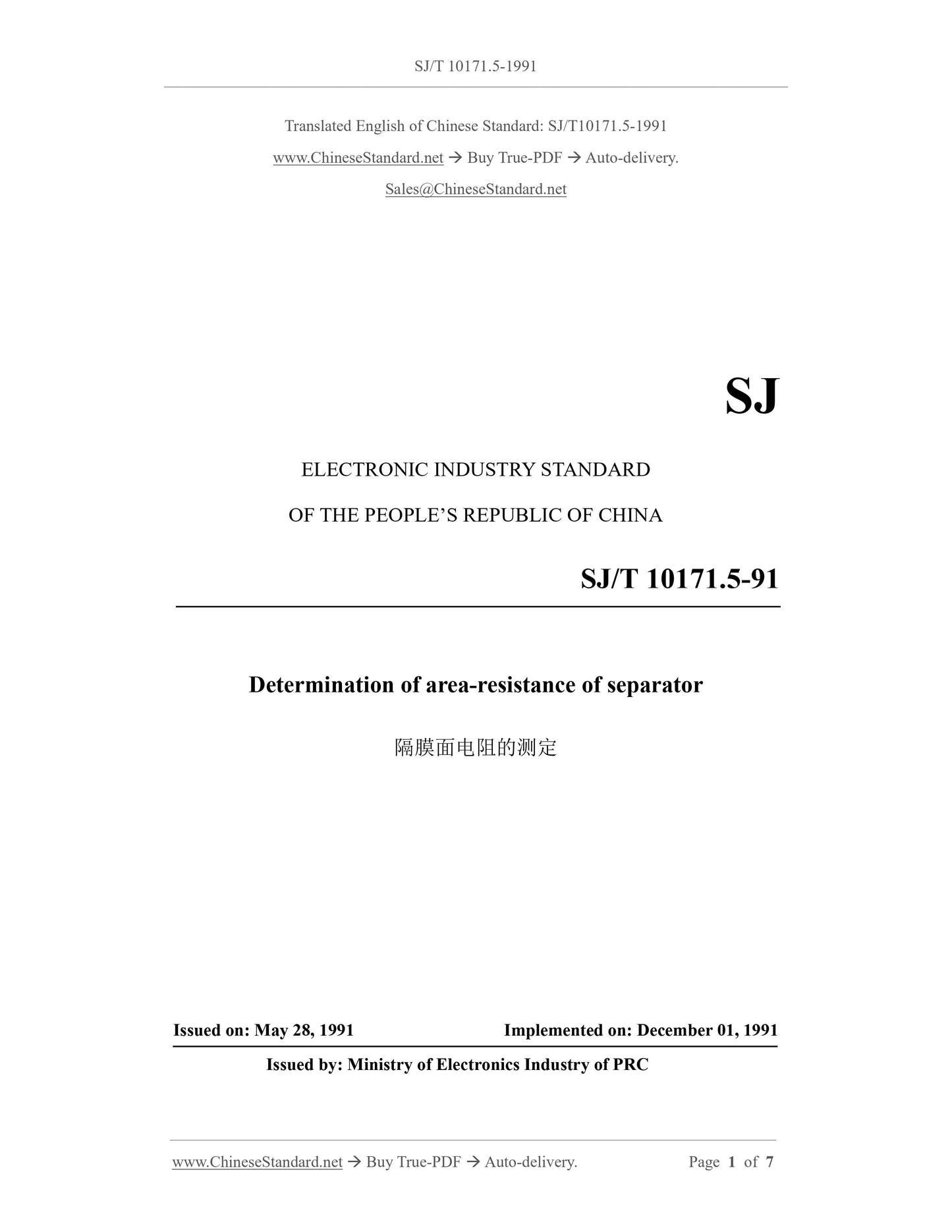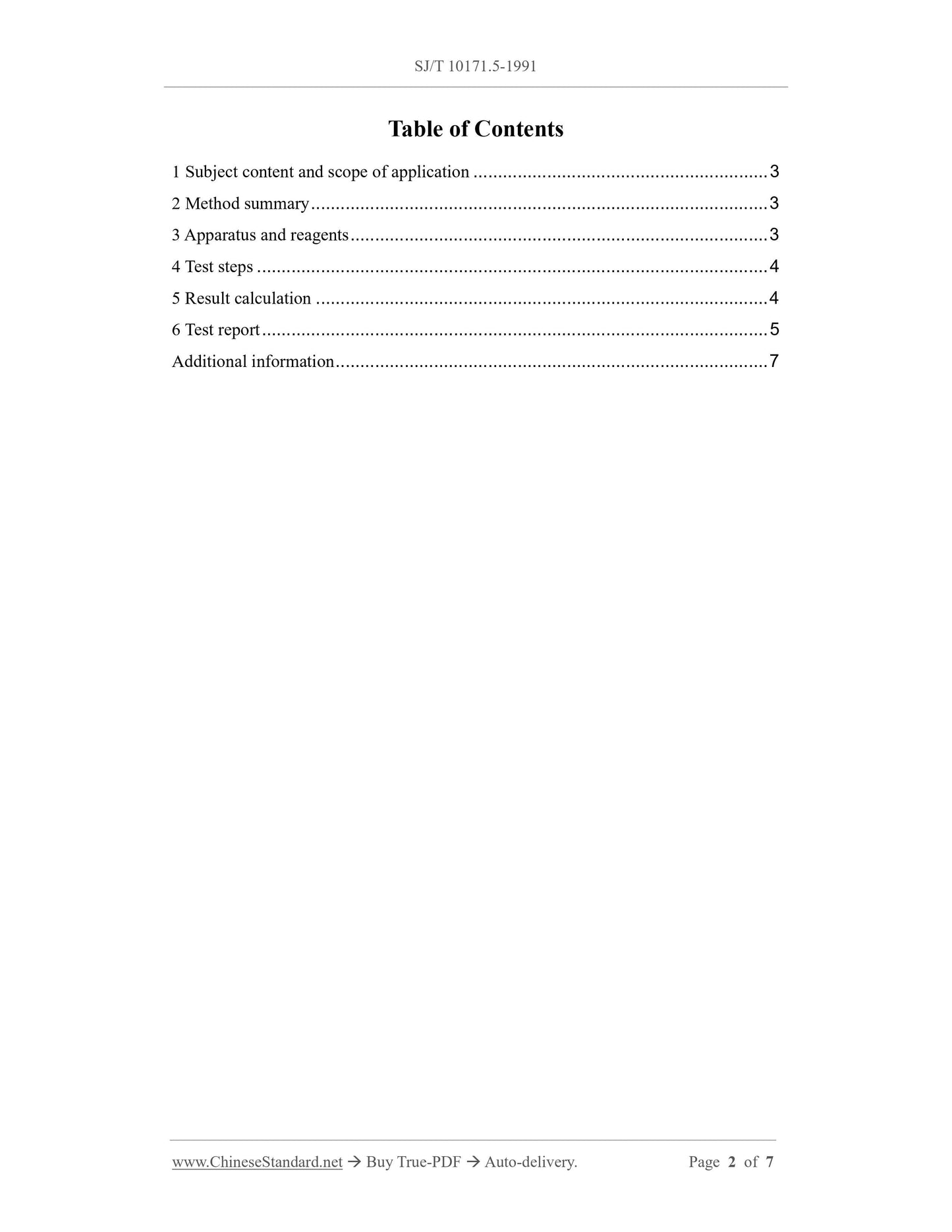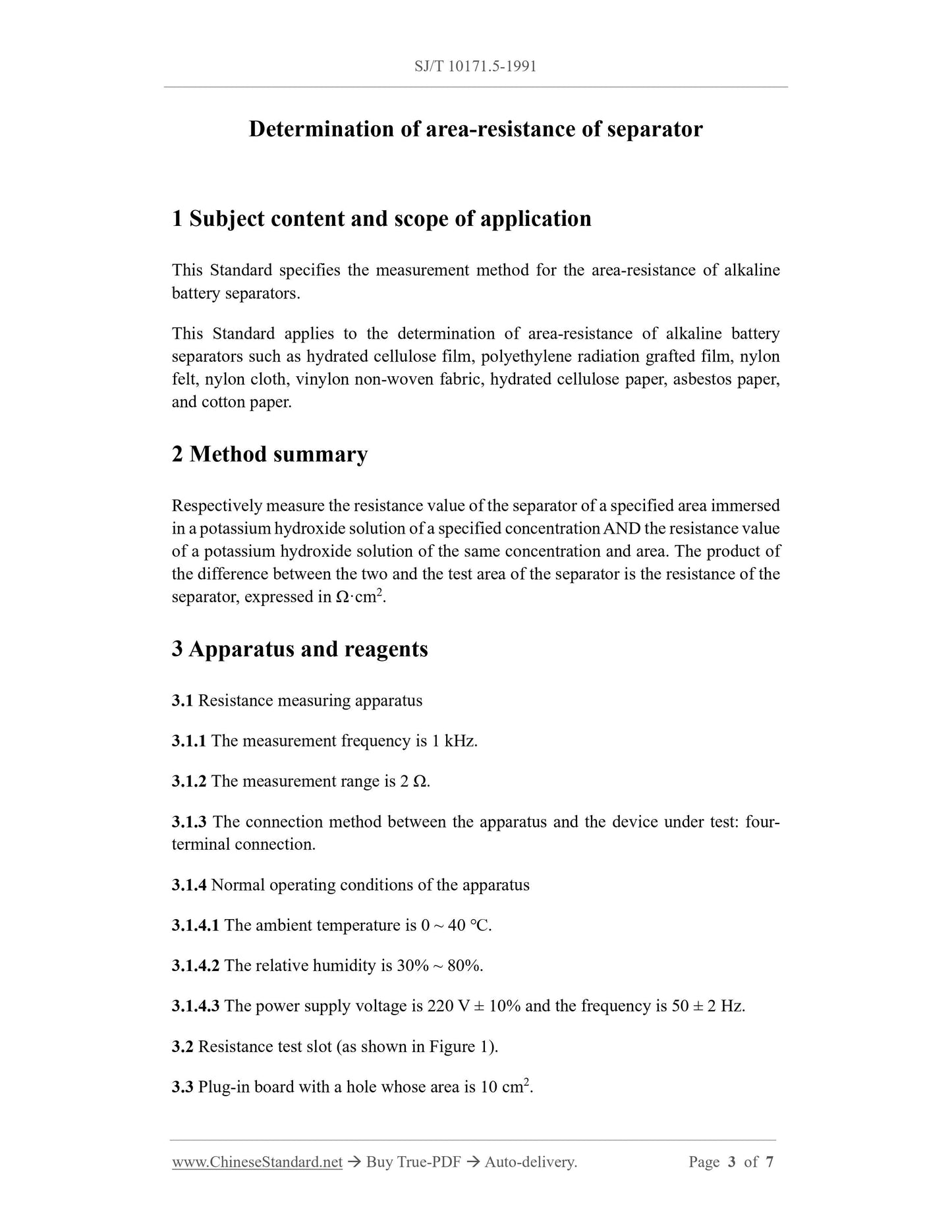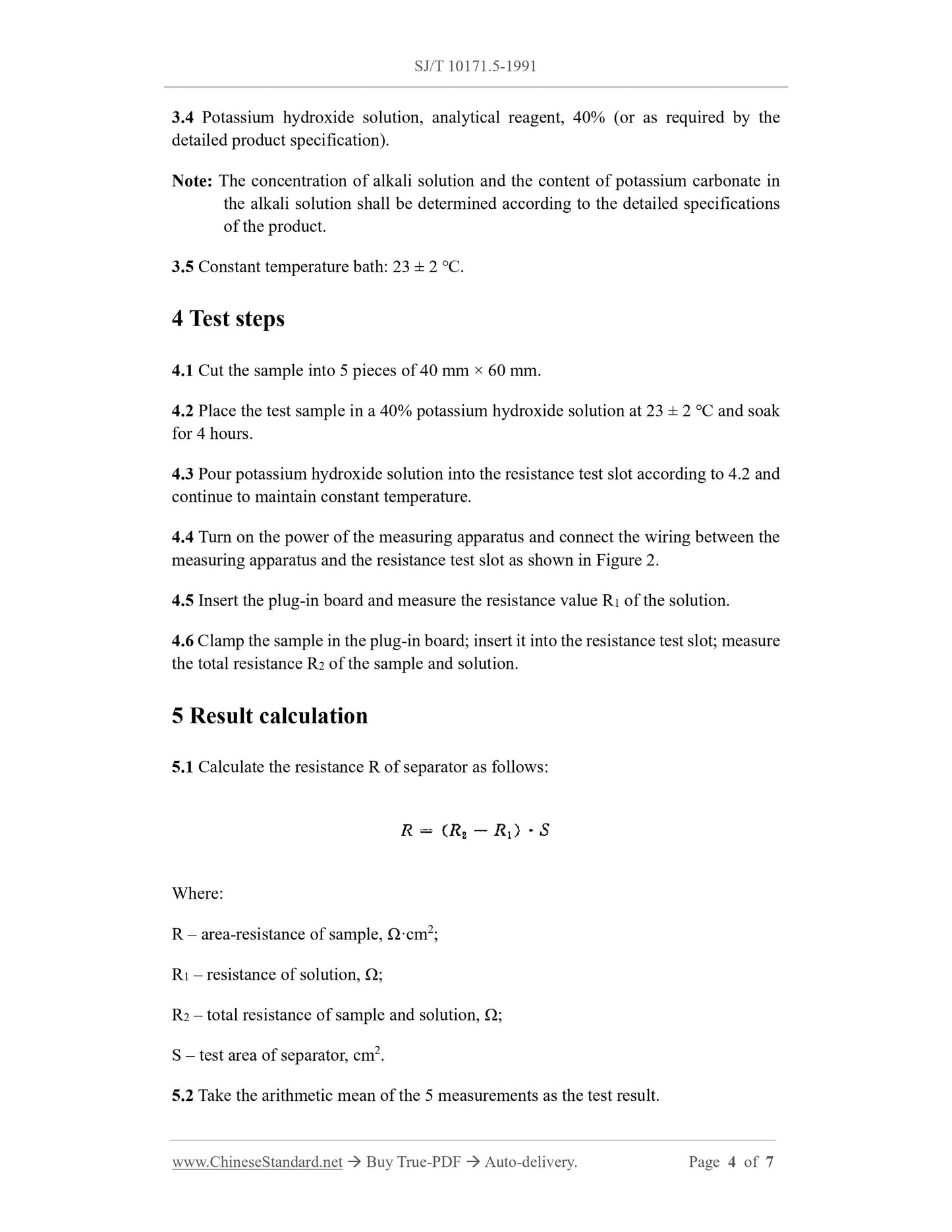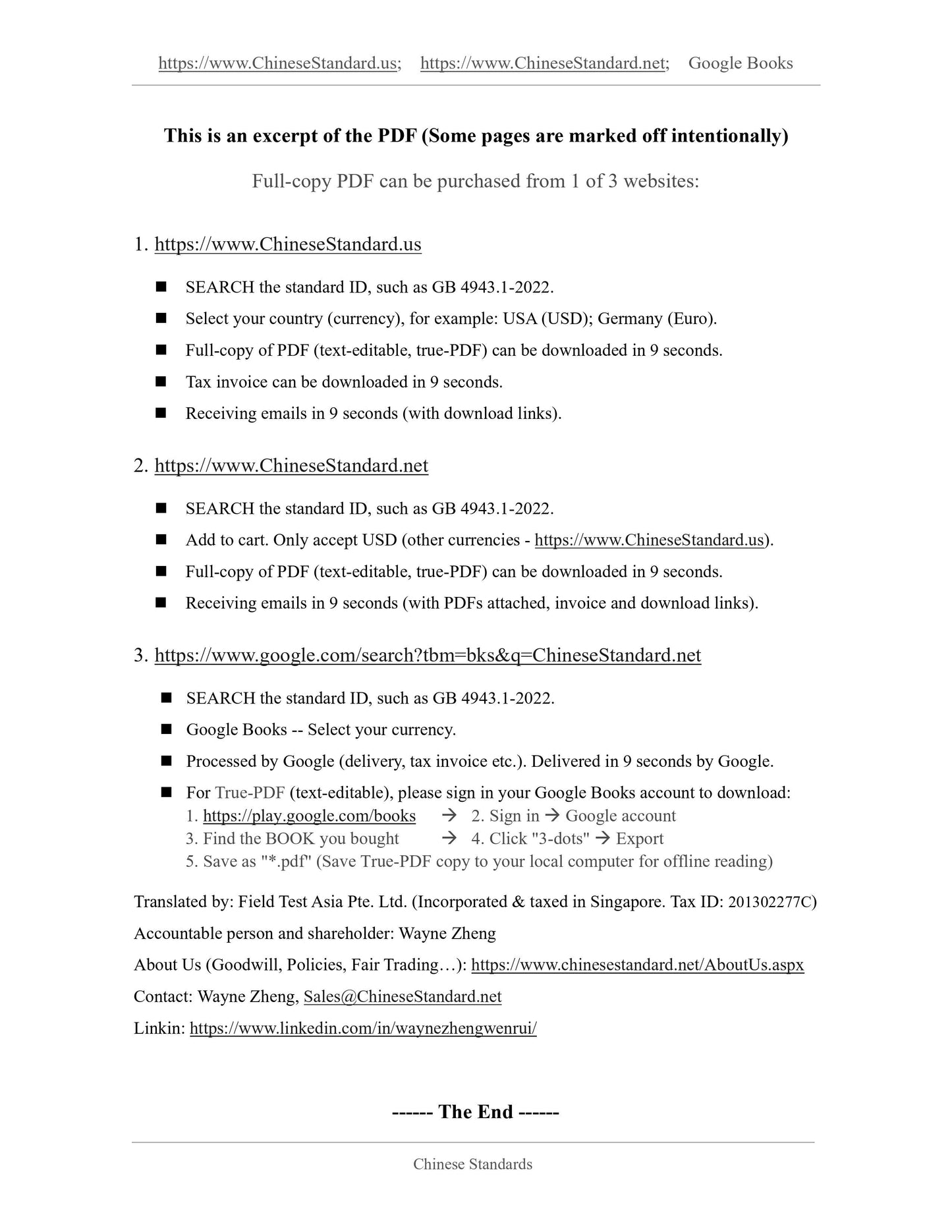1
/
de
5
PayPal, credit cards. Download editable-PDF and invoice in 1 second!
SJ/T 10171.5-1991 English PDF (SJT10171.5-1991)
SJ/T 10171.5-1991 English PDF (SJT10171.5-1991)
Prix habituel
$70.00 USD
Prix habituel
Prix promotionnel
$70.00 USD
Prix unitaire
/
par
Frais d'expédition calculés à l'étape de paiement.
Impossible de charger la disponibilité du service de retrait
Delivery: 3 seconds. Download true-PDF + Invoice.
Get QUOTATION in 1-minute: Click SJ/T 10171.5-1991
Historical versions: SJ/T 10171.5-1991
Preview True-PDF (Reload/Scroll if blank)
SJ/T 10171.5-1991: Determination of area-resistance of separator
SJ/T 10171.5-1991
SJ
ELECTRONIC INDUSTRY STANDARD
SJ/T 10171.5-91
Determination of area-resistance of separator
ISSUED ON. MAY 28, 1991
IMPLEMENTED ON. DECEMBER 01, 1991
Issued by. Ministry of Electronics Industry of PRC
Table of Contents
1 Subject content and scope of application... 3
2 Method summary... 3
3 Apparatus and reagents... 3
4 Test steps... 4
5 Result calculation... 4
6 Test report... 5
Additional information... 7
Determination of area-resistance of separator
1 Subject content and scope of application
This Standard specifies the measurement method for the area-resistance of alkaline
battery separators.
This Standard applies to the determination of area-resistance of alkaline battery
separators such as hydrated cellulose film, polyethylene radiation grafted film, nylon
felt, nylon cloth, vinylon non-woven fabric, hydrated cellulose paper, asbestos paper,
and cotton paper.
2 Method summary
Respectively measure the resistance value of the separator of a specified area immersed
in a potassium hydroxide solution of a specified concentration AND the resistance value
of a potassium hydroxide solution of the same concentration and area. The product of
the difference between the two and the test area of the separator is the resistance of the
separator, expressed in Ω·cm2.
3 Apparatus and reagents
3.1 Resistance measuring apparatus
3.1.1 The measurement frequency is 1 kHz.
3.1.2 The measurement range is 2 Ω.
3.1.3 The connection method between the apparatus and the device under test. four-
terminal connection.
3.1.4 Normal operating conditions of the apparatus
3.1.4.1 The ambient temperature is 0 ~ 40 ℃.
3.1.4.2 The relative humidity is 30% ~ 80%.
3.1.4.3 The power supply voltage is 220 V ± 10% and the frequency is 50 ± 2 Hz.
3.2 Resistance test slot (as shown in Figure 1).
3.3 Plug-in board with a hole whose area is 10 cm2.
3.4 Potassium hydroxide solution, analytical reagent, 40% (or as required by the
detailed product specification).
Note. The concentration of alkali solution and the content of potassium carbonate in
the alkali solution shall be determined according to the detailed specifications
of the product.
3.5 Constant temperature bath. 23 ± 2 ℃.
4 Test steps
4.1 Cut the sample into 5 pieces of 40 mm × 60 mm.
4.2 Place the test sample in a 40% potassium hydroxide solution at 23 ± 2 ℃ and soak
for 4 hours.
4.3 Pour potassium hydroxide solution into the resistance test slot according to 4.2 and
continue to maintain constant temperature.
4.4 Turn on the power of the measuring apparatus and connect the wiring between the
measuring apparatus and the resistance test slot as shown in Figure 2.
4.5 Insert the plug-in board and measure the resistance value R1 of the solution.
4.6 Clamp the sample in the plug-in board; insert it into the resistance test slot; measure
the total resistance R2 of the sample and solution.
5 Result calculation
5.1 Calculate the resistance R of separator as follows.
Where.
R – area-resistance of sample, Ω·cm2;
R1 – resistance of solution, Ω;
R2 – total resistance of sample and solution, Ω;
S – test area of separator, cm2.
5.2 Take the arithmetic mean of the 5 measurements as the test result.
Get QUOTATION in 1-minute: Click SJ/T 10171.5-1991
Historical versions: SJ/T 10171.5-1991
Preview True-PDF (Reload/Scroll if blank)
SJ/T 10171.5-1991: Determination of area-resistance of separator
SJ/T 10171.5-1991
SJ
ELECTRONIC INDUSTRY STANDARD
SJ/T 10171.5-91
Determination of area-resistance of separator
ISSUED ON. MAY 28, 1991
IMPLEMENTED ON. DECEMBER 01, 1991
Issued by. Ministry of Electronics Industry of PRC
Table of Contents
1 Subject content and scope of application... 3
2 Method summary... 3
3 Apparatus and reagents... 3
4 Test steps... 4
5 Result calculation... 4
6 Test report... 5
Additional information... 7
Determination of area-resistance of separator
1 Subject content and scope of application
This Standard specifies the measurement method for the area-resistance of alkaline
battery separators.
This Standard applies to the determination of area-resistance of alkaline battery
separators such as hydrated cellulose film, polyethylene radiation grafted film, nylon
felt, nylon cloth, vinylon non-woven fabric, hydrated cellulose paper, asbestos paper,
and cotton paper.
2 Method summary
Respectively measure the resistance value of the separator of a specified area immersed
in a potassium hydroxide solution of a specified concentration AND the resistance value
of a potassium hydroxide solution of the same concentration and area. The product of
the difference between the two and the test area of the separator is the resistance of the
separator, expressed in Ω·cm2.
3 Apparatus and reagents
3.1 Resistance measuring apparatus
3.1.1 The measurement frequency is 1 kHz.
3.1.2 The measurement range is 2 Ω.
3.1.3 The connection method between the apparatus and the device under test. four-
terminal connection.
3.1.4 Normal operating conditions of the apparatus
3.1.4.1 The ambient temperature is 0 ~ 40 ℃.
3.1.4.2 The relative humidity is 30% ~ 80%.
3.1.4.3 The power supply voltage is 220 V ± 10% and the frequency is 50 ± 2 Hz.
3.2 Resistance test slot (as shown in Figure 1).
3.3 Plug-in board with a hole whose area is 10 cm2.
3.4 Potassium hydroxide solution, analytical reagent, 40% (or as required by the
detailed product specification).
Note. The concentration of alkali solution and the content of potassium carbonate in
the alkali solution shall be determined according to the detailed specifications
of the product.
3.5 Constant temperature bath. 23 ± 2 ℃.
4 Test steps
4.1 Cut the sample into 5 pieces of 40 mm × 60 mm.
4.2 Place the test sample in a 40% potassium hydroxide solution at 23 ± 2 ℃ and soak
for 4 hours.
4.3 Pour potassium hydroxide solution into the resistance test slot according to 4.2 and
continue to maintain constant temperature.
4.4 Turn on the power of the measuring apparatus and connect the wiring between the
measuring apparatus and the resistance test slot as shown in Figure 2.
4.5 Insert the plug-in board and measure the resistance value R1 of the solution.
4.6 Clamp the sample in the plug-in board; insert it into the resistance test slot; measure
the total resistance R2 of the sample and solution.
5 Result calculation
5.1 Calculate the resistance R of separator as follows.
Where.
R – area-resistance of sample, Ω·cm2;
R1 – resistance of solution, Ω;
R2 – total resistance of sample and solution, Ω;
S – test area of separator, cm2.
5.2 Take the arithmetic mean of the 5 measurements as the test result.
Share
